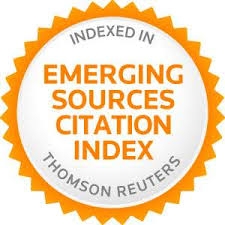Deserción escolar universitaria: Patrones para prevenirla aplicando minería de datos educativa
Resumen
Recientemente, el uso de técnicas de minería de datos educativa ha cobrado gran relevancia al aplicarlas en la predicción del desempeño, creación de modelos predictivos de retención, perfiles de comportamiento, fracaso escolar, entre otros. En este trabajo se presenta la aplicación del algoritmo selección de atributos para identificar los factores más importantes que inciden en la decisión de desertar; también, se utilizan árboles de decisión para definir patrones que pueden alertar una inminente deserción. Se adaptó un instrumento y se administró vía web a 300 estudiantes de IES pública y 200 estudiantes de IES privada actualmente inscritos en algún programa de nivel superior. Mediante el algoritmo selección de atributos se encontraron 27 factores relevantes, dentro de los tres factores principales se reconocen la falta de asesorías, la falta de un ambiente estudiantil adecuado y la falta de seguimiento académico, mientras que, por medio del árbol de decisión se encontraron 7 patrones, en donde uno de ellos incluye factores como: ambiente estudiantil, apoyos financieros insuficientes, experiencia de una situación incómoda, lugar que ocupa la elección de la carrera, entre otros. Finalmente, se ha visto que la deserción escolar no depende de un solo factor, sino que es multifactorial y que es imperativo ampliar la muestra a otras ciudades de manera que se puedan aplicar diversos algoritmos que proporcionen mayor información que conduzcan al establecimiento de mecanismos certeros para disminuir los índices de deserción universitaria en función de las características de la población estudiantil según la región.
Palabras clave
Referencias
Abarca R., A., & Sánchez V., M. A. (2005). La deserción estudiantil en la educación superior: el caso de la Universidad de Costa Rica. Revista Electrónica "Actualidades Investigativas en Educación", 5, 1-22. https://bit.ly/35TVeLE
Abu-Oda, G. S., & El-Halees, A. M. (2015). Data mining in higher education: university student dropout case study. International Journal of Data Mining y Knowledge Management Process (IJDKP), 5(1), 15-27. https://doi.org/10.5121/ijdkp.2015.5102
Agaoglu, M. (2016). Predicting instructor performance using data mining techniques in higher education. IEEE Access, 4. https://doi.org/10.1109/ACCESS.2016.2568756
Al-Barrak, M. A., & Al-Razgan, M. (2016). Predicting student’s final GPA using decision trees: a case study. International Journal of Information and Education Technology, 6(7), 528-533. https://doi.org/10.7763/IJIET.2016.V6.745
Alkhasawneh, R., & Hargraves, R. H. (2014). Developing a Hybrid Model to Predict Student First Year Retention in STEM Disciplines Using Machine Learning Techniques. Journal of STEM Education: Innovations and Research, 5(3), 35-42. ERIC. https://bit.ly/2Rd04hi
Aulck, L., Velagapudi, N., Blumenstock, J., & West, J. (2017). Predicting Student Dropout in Higher Education. Machine Learning in Social Good Applications, 16-20. https://bit.ly/3aRtae6
Barbosa M. L. M., Serra da Cruz, S. M., & Zimbrão, G. (2014). The Impact of High Dropout Rates in a Large Public Brazilian University: A Quantitative Approach Using Educational Data Mining. 6th International Conference on Computer Supported Education (págs. 124-129). Barcelona, Spain: INSTICC. https://bit.ly/2ZsYFbD
Bird, S., Klein, E., & Loper, E. (2009). Natural Language Processing with Python. USA: O´Really Media, Inc.
Bishop, C. M. (2007). Pattern recognition and Machine Learning. Singapore: Springer.
Cabrera, L., Bethencour, J. T., Álvarez P. P., & González A. M. (2006). El problema del abandono de los estudios universitarios. RELIEVE, 12(2), 171-203. https://doi.org/10.7203/relieve.12.2.4226
Carvajal O. P., & Trejos C. Á. A. (2016). Revisión de estudios sobre deserción estudiantil en educación superior en Latinoamérica bajo la perspectiva de Pierre Bourdieu. Congresos CLABES. Quito, Ecuador: Escuela Politécnica Nacional. https://bit.ly/2UP9mlT
Cha, G.-W., Kim, Y.-C., Moon, H. J., & Hong, W.-H. (2017). New approach for forecasting demolition waste generation using chisquared automatic interaction detection (CHAID) method. Journal of Cleaner Production, 168, 375-385. https://doi.org/10.1016/j.jclepro.2017.09.025
Chen, W., Xie, X., Peng, J., Wang, J., Duan, Z., & Hong, H. (2017). GIS-based landslide susceptibility modelling: a comparative assessment of kernel logistic regression, Naïve-Bayes tree, and alternating decision tree models. Geomatics, Natural Hazards and Risk, 8(2), 950-973. https://doi.org/10.1080/19475705.2017.1289250
Chiheb, F., Boumahdi, F., Bouarfa, H., & Boukraa, D. (2017). Predicting students’ performance using decision trees: Case of an Algerian University. 2017 International Conference on Mathematics and Information Technology (ICMIT). Adrar, Algeria: IEEE. https://doi.org/10.1109/MATHIT.2017.8259704
Dekker, G. W., Pechenizki, M., & Vleeshouwers, J. M. (2009). Predicting Students Drop Out: A Case Study. 2nd International Conference on Educational Data Mining (págs. 41-50). Cordoba, Spain: International Educational Data Mining Society. https://bit.ly/2ZlH1a3
Delen, D. (2011). Predicting Student Attrition with Data Mining Methods. Journal of College Student Retention: Research, Theory y Practice, 13(1), 17-35. https://doi.org/10.2190/CS.13.1.b
Del Pobil, A. P., Mira, J., & Ali, M. (1998). Tasks and Methods in Applied Artificial Intelligence. 11th International Conference on Industrial and Engineering Applications of Artificial In telligence and Expert Systems. 1416. Castellón, España: Springer.
Estrada-Danell, R. I., Zamarripa-Franco, R. A., Zúñiga-Garay, P. G., & Martínez-Trejo, I. (2016). Aportaciones desde la minería de datos al proceso de captación de matrícula de instituciones de educación superior particulares. Revista Electrónica Educare, 20(3), 1-21. https://doi.org/10.15359/ree.20-3.11
Fozdar, B. I., Kumar, L. S., & Kannan, S. (2006). A Survey of a Study on the Reasons Responsible for Student Dropout from the Bachelor of Science Programme at Indira Gandhi National Open University. International Review of Research in Open and Distance Learning, 7(3), 1-15. https://doi.org/10.19173/irrodl.v7i3.291
Frank, E., Hall, Mark A., & Witten I. H. (2016). The WEKA Workbench. Online Appendix for "Data Mining: Practical Machine Learning Tools and Techniques", Morgan Kaufmann, Fourth Edition, 2016.
Freitas, A. A. (2002). Data Mining and Knowledge Discovery with Evolutionary Algorithms. The Netherlands: Springer-Verlag. https://doi.org/10.1007/978-3-662-04923-5
Guevara, C., Sanchez-Gordon, S., Arias-Flores, H., Varela-Aldás, J., Castillo-Salazar, D., Borja, M., . . . Yandún-Velasteguí, M. (2019). Detection of Student Behavior Profiles Applying Neural Networks and Decision Trees. 1026, págs. 591-597. Munich, Germany: Springer, Cham. https://doi.org/10.1007/978-3-030-27928-8_9
Gupta, B., Rawat, A., Jain, A., Arora, A., & Dhami, N. (2017). Analysis of Various Decision Tree Algorithms for Classification in Data Mining. International Journal of Computer Applications, 163(8), 15-19. https://doi.org/10.5120/ijca2017913660
Han, J., Kamber, M., & Pei, J. (2011). Data mining: concepts and techniques. Amsterdam: Morgan Kaufmann.
INEGI. (2018). Estadísticas a propósito del día mundial de la población (11 de julio). Ciudad de México: INEGI. https://bit.ly/2xbnZHd
Jadhav, S. D., & Channe, H. P. (2016). Comparative Study of K-NN, Naive Bayes and Decision Tree Classification Techniques. International Journal of Science and Research (IJSR), 5(1), 1842-1845. https://doi.org/10.21275/v5i1.NOV153131
Kabra, R. R., & Bichkar, R. S. (2011). Performance Prediction of Engineering Students using Decision Trees. International Journal of Computer Applications, 36(11), 9-12. https://bit.ly/2JdxckV
Kotsiantis, S., Pierrakeas, C., & Pintelas, P. E. (2003). Preventing Student Dropout in Distance Learning Using Machine Learning Techniques. Knowledge-Based Intelligent Information and Engineering Systems, 7th International Conference (págs. 267-274). Oxford, UK.: Springer-Verlag Berlin Heidelberg. https://doi.org/10.1007/978-3-540-45226-3_37
Kumar Y. S., Bharadwaj, B., & Pal, S. (2012). Mining Education Data to Predict Student's Retention: A comparative Study. International Journal of Computer Science and Information Security, 10(2), 113-117. https://bit.ly/2JJw9t1
Lavado, P., & Gallegos, J. (2005). La dinámica de la deserción escolar en el Perú: un enfoque usando modelos de duración. Lima, Perú: Universidad del Pacífico. https://bit.ly/39PH3rJ
Londoño A. L. F. (2013). Factores de riesgo presentes en la deserción estudiantil en la Corporación Universitaria Lasallista. Revista Virtual Universidad Católica del Norte (38), 183-194. https://bit.ly/1OnjEwM
Longest, K. C. (2019). Using Stata for Quantitative Analysis. California, USA: SAGE Publications.
M.P. van der Aalst, W. (2011). Process Mining: Discovery, Conformance and Enhancement of Business Processes (Google eBook). London, UK: Springer-Verlag. https://doi.org/10.1007/978-3-642-19345-3
Márquez-Vera C., Romero M. C., & Ventura S. S. (2012). Predicción del Fracaso Escolar mediante Técnicas de Minería de Datos. Revista Iberoamericana de Tecnologías del Aprendizaje, 7(3), 109-117. https://bit.ly/2zoZKmo
Márquez-Vera, C., Cano, A., Romero, C., Mohammad N. A. Y., Fardoun, H. M., & Ventura, S. (2016). Early dropout prediction using data mining: a case study with high school students. Expert Systems, 33(1), 107-125. https://doi.org/10.1111/exsy.12135
Mitchell, T. M. (1997). Machine Learning. Singapore: McGraw-Hill.
Mitchell, T. M. (2000). Decision Tree Learning. Washington State University. https://bit.ly/2N1AI32
Morales C. J., & Parraga-Alava, J. (2018). How Predicting The Academic Success of Students of the ESPAM MFL?: A Preliminary Decision Trees Based Study. 2018 IEEE Third Ecuador Technical Chapters Meeting (ETCM). Cuenca, Ecuador: IEEE. https://doi.org/10.1109/ETCM.2018.8580296
Morillas, A. (2014). Muestreo en poblaciones finitas. Notas del curso. Málaga-España: Universidad de Málaga. https://bit.ly/2JLLA3K
OECD. (2017). Skills Strategy Diagnostic Report: Mexico 2017, OECD Skills Studies. París: OECD Publishing. https://doi.org/10.1787/9789264287679-en
OECD. (2019). Higher Education in Mexico: Labour Market Relevance and Outcomes, Higher. París: OECD Publishing. https://doi.org/10.1787/9789264309432-en
Pal, S. (2012). Mining Educational Data Using Classification to Decrease Dropout Rate of Students. International Journal of Multidisciplinary Sciences and Engineering, 3(5), 35-39. https://bit.ly/2xVhAjc
Raju, D. y Schumacker, R. (2015). Exploring Student Characteristics of Retention that Lead to Graduation in Higher Education Using Data Mining Models. Journal of college student retention: Research, Theory y Practice, 16(5), 563-591. https://doi.org/10.2190/CS.16.4.e
Rodríguez-Maya, N. E., Lara-Álvarez, C., May-Tzuc, O., & Suárez-Carranza, B. A. (2017). Modeling Students' Dropout in Mexican Universities. Research in Computing Science, 139, 163-175. https://doi.org/10.13053/rcs-139-1-13
Ruíz C., L. (2009). Deserción en la educación superior recinto Las Minas. Período 2001-2007. Ciencia e Interculturalidad, 4(2), 30-46. https://doi.org/10.5377/rci.v4i1.288
Sara, N. B., Halland, R., Igel, C., & Alstrup, S. (2015). High-School Dropout Prediction Using Machine Learning: A Danish Large-scale Study. European Symposium on Artificial Neural Networks, Computational Intelligence and Machine Learning (págs. 319-324). Bruges, Belgium: i6doc.com. https://bit.ly/2MFgzkp
Secretaría de Educación Pública. (2019). Abandono escolar. Ciudad de México: SEP.
Secretaría de Educación Pública. (2019). Principales cifras del sistema educativo nacional 2018-2019. Ciudad de México: Dirección General de Planeación, Programación y Estadística. https://bit.ly/2yCwivX
Sharma, H., & Kumar, S. (2016). A Survey on Decision Tree Algorithms of Classification in Data Mining. International Journal of Science and Research (IJSR), 5(4), 2094-2097. https://doi.org/10.21275/v5i4.NOV162954
Sivakumar, S., Venkataraman, S., & Selvaraj, R. (2016). Predictive Modeling of Student Dropout Indicators in Educational Data Mining using Improved Decision Tree. Indian Journal of Science and Technology, 9(4), 1-5. https://doi.org/10.17485/ijst/2016/v9i4/87032
Universidad Tecnológica de Tabasco. (2019). Glosario de Términos. Villermosa, Tabasco: Universidad Tecnológica de Tabasco. https://bit.ly/2xZ60DK
Ustebay, S., Turgut, Z., & Ali A. M. (2018). Intrusion Detection System with Recursive Feature Elimination by Using Random Forest and Deep Learning Classifier. 2018 International Congress on Big Data, Deep Learning and Fighting Cyber Terrorism (IBIGDELFT) (págs. 71-76). Ankara, Turkey: IEEE. https://doi.org/10.1109/IBIGDELFT.2018.8625318
Vélez, A., & López, J. D. F. (2004). Estrategias para vencer la deserción universitaria. Educación y Educadores (7). 177-203. https://bit.ly/39MgeEJ
Valle G. R., Eslava G. G., Manzano P. A., & García M. M. (2014). Encuesta Internacional sobre el Abandono en la Educación Superior. Unión Europea. https://bit.ly/2p8k2Pk
Vijayalakshmi, M., & Kumar, A. S. (2011). Efficiency of decision trees in predicting student's academic performance. Computer Science y Information Technology, 335-343. https://doi.org/10.5121/csit.2011.1230
Vries, W., León A. P., Romero M. J. F., & Hernández S. I. (2011). ¿Desertores o decepcionados? Distintas causas para abandonar los estudios universitarios. Revista de la Educación Superior, 40(160), 29-49. https://bit.ly/1TzOzru
Witten, I. H., & Frank, E. (2005). Data Mining: Practical machine learning tools and techniques. San Francisco, CA: ELSEVIER.
Witten, I. H., Frank, E., & Hall, M.A. (2011). Data mining: Practical machine learning tools and techniques (3a. ed.). Morgan Kaufmann Publishers, Burlington. https://doi.org/10.1016/B978-0-12-374856-0.00001-8
Yamao, E., Saavedra, L. C., Campos P. R., & Huancas H. V. D. (2018). Prediction of academic performance using data mining in first year students of peruvian university. CAMPUS, XXIII(26), 151-160. https://doi.org/10.24265/campus.2018.v23n26.05
Yang, S., Lu, O., Huang, A., Huang , J., Ogata, H., & Lin, A. (2017). Predicting Students' Academic Performance Using Multiple Linear Regression and Principal Component Analysis. Journal of Information Processing, 170-176. https://doi.org/10.2197/ipsjjip.26.170
Yukselturk, E., Ozekes, S., & Kılıç T. Y. (2014). Predicting dropout student: an application of data mining methods in an online education program. European Journal of Open, Distance and e-Learning, 17(1), 119-133. https://doi.org/10.2478/eurodl-2014-0008
Enlaces refback
- No hay ningún enlace refback.

Este obra está bajo una licencia de Creative Commons Reconocimiento-NoComercial 4.0 Internacional.


